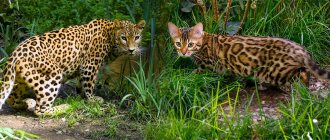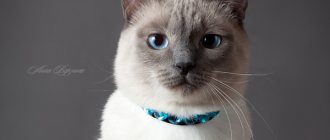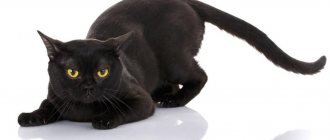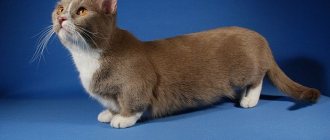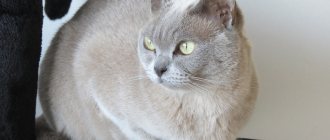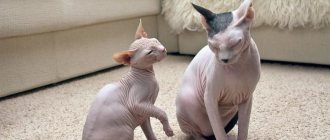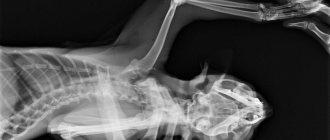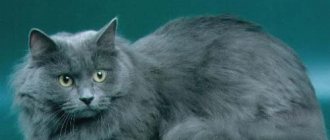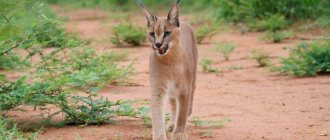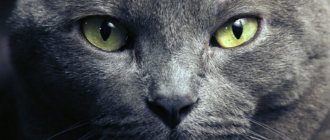A graceful beauty with a thousand-year history will easily find a place in the human heart and enter the very soul. Abyssinian cat with her strong, flexible and graceful body, she commands respect not only from those who keep her, but also from everyone who watches the animal’s games and its behavior in general. Keeping such a charming animal in your home is a pleasure - caring for Abyssinians is not burdensome, which is also a significant advantage of this breed. The affectionate beauty also doesn’t mind settling in the house of a kind and sociable person - this creature brings real joy to the family!
History of the origin of the Abyssinian cat breed
global $ads_google;
//data-ad-slot=”2475549904″ $ads_google = empty($ads_google) ? false : true; ?> if ($ads_google == false) {?> $ads_google = true; ?> } ?> It is not only man who leaves a mark on history. Many cat tracks stretch from Abyssinia, or today's Ethiopia. This is one of the versions that explains the origin of this interesting graceful breed. There are also mentions of Abyssinians in the kingdom of Ancient Egypt. It is believed that these cats became the prototype of the goddess Bastet - a woman with a cat's head. There is an opinion that representatives of the Egyptian branch did not survive to this day, and today's beauties are only the result of the hard work of British breeders.
The first Abyssinian cat set foot on the shores of Great Britain in 1868, and just 3 years later the beautiful Zula was exhibited at the Crystal Palace. A year later, Abyssinian cats were talked about in the media. In 1874, a book by Gordon Stables was published, dedicated to the varieties of cat breeds, which already contained information about new cats.
12 years have passed since the Abyssinian pussy came to England, and the breed gained public recognition. They decided to consolidate and improve the qualities by crossing with a British shorthair cat.
After this, the popularity and prevalence of the Abyssinian cat in Europe and America began to grow rapidly. The first breeding cats and cats had a silver color and the remainder of the pattern in the form of stripes.
Silver-colored cats were discovered in America in 1907, but this color was not recognized by felinologists there, and in the 1920s there were almost none left in England. During the Second World War, cat populations declined greatly and recovered at a very slow pace. Even in 1978, after the feline leukemia epidemic, there were no more than a dozen manufacturers in England.
In the 21st century, the appearance of the breed has changed: the size of the animal has changed, the ears have grown, and many new colors have appeared. Today, Abyssinians are loved and popular all over the world.
Proper care
As we said above, proper care is the key to your cat’s health, which, in turn, will affect its life expectancy.
Abyssinians love walks
However, the owners of Abyssinians do not have to work particularly hard, because these animals are unpretentious. Let's see what you need to do to provide the animal with a decent standard of living.
1. Once every 6-8 days you need to comb your cat with a brush:
- made of metal;
- equipped with fine teeth.
2. During the spring molting period, the animal must be bathed, since the skin will be renewed along with the old fur, so it is necessary to remove both hair and dead epithelium.
3. Once a year, get the required vaccinations against:
- rabies;
- panleukopenia;
- rhinotracheitis;
- chlamydia (for cats participating in breeding), etc.
At what age is it best to vaccinate cats?
4. Before vaccinations, or preferably once every six months, it is necessary to deworm animals, that is, give them special anti-worm tablets.
5. Trim nails and provide a scratching post (this is very important for the health of paws and claws).
6. Cross with the same breed, at least for the reason that future kittens will need to arrange their fate, making it comfortable.
Another important point that needs to be monitored is the nutrition of the “Abyssinians”. Read the next section for details on how to feed them.
Description of Abyssinian cats
global $ads_google;
//data-ad-slot=”2475549904″ $ads_google = empty($ads_google) ? false : true; ?> if ($ads_google == false) {?> $ads_google = true; ?> } ?> After a long selection, Abyssinian cats were divided into two types: the European type and the American one. Gradually, the differences between each species become more striking. Already now there is a noticeable difference in the skeleton and some features of the body structure.
Strict standards have been established for the wonderful Abyssinian cats. According to the description, the animals should not exceed average size and have a refined, flexible, muscular body.
The wedge-shaped head rests on a slender neck. The contours of the head are rounded, the muzzle should also not be sharp. The chin does not protrude.
The large ears are wide at the base and rounded towards the tips.
The Abyssinian's eyes should be large and very expressive, shaped like almonds. The breed's eye color can be either green or amber and includes a range between these characteristics.
The Abyssinian shorthair cat shows the world beautiful limbs, long, graceful and slender, with narrow and oval paws.
Descendants of cats from Abyssinia are the owners of a long tail, thickened at the base and pointed at the tip.
Graceful, sculpted cats have thick, short and silky fur with double and even triple ticking on each hair.
The breed is not on the list of hypoallergenic.
There is debate within organizations about acceptable colors. So far, several fur coat colors do not cause doubts and discord: blue, wild, sorrel, red, fawn.
The wild color will have a reddish-brown coat with black or dark brown ticking. The undercoat will be a beautiful orange-brown color.
The sorrel color is an offshoot of the wild color and is unique in the cat world. Only the Abyssinian breed has it. Reminiscent of a mixture of shades: copper, apricot, chocolate brown, red.
A warm beige coat color with slate gray ticking and a pink-beige undercoat is called a blue coat.
Flaming red is considered a red color, the undercoat coloring is also a reddish shade, and the ticking will be chocolate brown.
The faun has a pleasant pinkish-beige coat with the same undercoat. The light brown color of the ticking is interesting.
Dimensions and weight of Abyssinian cats
global $ads_google;
//data-ad-slot=”2475549904″ $ads_google = empty($ads_google) ? false : true; ?> if ($ads_google == false) {?> $ads_google = true; ?> } ?> The animals have a very proportional body and are considered average in size among domestic cats. Weight standards range from 4-7.5 kg. A weight of 5-6 kg is considered ideal, but this figure depends on gender, age, nutrition, castration or sterilization, and lifestyle. Don’t worry if a young cat weighs a little more than 4 kg, this is an indicator of the animal’s normal development.
As you can see, the growth and development of an Abyssinian kitten over the months is not very different from another medium-sized cat.
Table of approximate weight by month
| Age | Female | Male |
| 1 month | 290-600 gr | 520-800 gr |
| 2 months | 560-970 gr | 950-1600 gr |
| 3 months | 1.2-1.8 kg | 1.4-2.6 kg |
| 4 months | 1.6-2.5 kg | 1.7-3.7 kg |
| 5 months | 1.9-3 kg | 2.1-4.1 kg |
| 6 months | 2.1-3.5 kg | 2.5-4.4 kg |
| 8 months | 2.3-3.9 kg | 2.9-5 kg |
| 10 months | 2.7-4.2 kg | 3.4-5.9 kg |
| 1 year | 3.1-4.7 kg | 3.7-6.6 kg |
| 2 years | 3.6-6kg | 4-7.5 kg |
Metis with British
The British cat is an indigenous breed with an ancient history of development, which begins in the days of the Roman legionnaires. These animals are endowed with refined manners, prefer solitude, do not like noisy companies and too active games. The most common crosses of British cats are with ordinary cats, with Toygers and with Siamese.
A mix of a British cat and a regular cat
Outbred cats have an amazing ability to quickly adapt to their environment. These animals are independent, unpretentious, endowed with excellent hunting skills that allow them not to die of hunger, which cannot be said about most purebred domestic cats.
It is worth noting that street cats do not strive for privacy; they are sociable and do not mind contact with people if they behave kindly. Animals that are brought into the home at an early age are socialized no worse than purebred cats.
Mixed breeds of a British cat and a regular one are most common. Sometimes at first glance it is even difficult to distinguish who is who. Half-breeds have the same massive bone structure and broad chest, but are slightly smaller in size. Developed cheeks make the muzzle round.
Coat colors are varied. The British are characterized by about 200 colors, so the color options for mixed breeds are unlimited. There are individuals with a color-point mask like the Siamese or spectacular silver chinchilla ticking.
The Métis partly adopt the British desire for privacy. Such animals are more eager to be the center of attention; they are quite sociable and responsive.
Interesting. At an early age, half-breeds exhibit to a greater extent the manners of mongrel animals, and in adulthood they show prudence and sedateness - qualities inherent in the British breed.
Toyger/British mix
Mixed Toyger + British cat is an animal with a clear striped pattern on its fur. The Toyger breed was developed relatively recently and received admission to the exhibition career in 2007. These cats are characterized by the only so-called brindle color.
Toygers are much thinner than the British, have an elongated body and long legs. Mestizos are distinguished by an average constitution, proportional physique, and a beautiful fur coat with a tabba pattern. The bands may be clear or blurred, but are present in 95% of cases.
The character of half-breeds is more reminiscent of the British. They are just as prim and calm. Second-generation mestizos resemble only one of their parents.
Mix of Siamese and British cat
Mixed breeds of British and Siamese cats are spectacular beauties with a solid color, for which the C gene is responsible, which is involved in the formation of the color point color.
The Siamese color depends on the animal's body temperature. The body of cats is warmer, so the gene does not appear in this part of the body. The fur on the body is always light. The limbs, ears, muzzle and tail are cooler, so the coat is darker in these areas. The British are also characterized by the Siamese color, which is inherited.
A cross between a Siamese and a Briton looks heavy, has a massive bone structure and a wide chest, long legs and a tail.
Kittens inherit an independent character and egocentrism (from the British), resentment and rancor (from the Siamese). The British genotype is considered dominant, which is often expressed in complete resemblance to the aristocratic breed.
Habits and character of Abyssinian cats
The characteristic behavior of cats can be different, but in the case of the Abyssinian cat, its character completely corresponds to its appearance. Just by looking at this graceful perfection, its playfulness and curiosity become apparent. These same character traits and at the same time amazing balance will not allow the cat to interfere excessively in the owner’s life, although the pet will not object to the manifestation of care from a loved one.
Both adults and children will enjoy the cat's sociability: they are affectionate and at the same time independent creatures. In order for an Abyssinian cat to honor its owner with its trust, judging by the reviews, the training process should not include harsh shouting, and it is even more unthinkable to use physical force.
How to litter train an Abyssinian kitten
The owners who keep an Abyssinian cat claim that this is a true, loyal friend. The animal is responsive to affection and pays in kind. These pets do not like loneliness. Although they do not get in the way of their household members, they nevertheless feel more comfortable knowing that their beloved owners are in the apartment nearby. Cats love to participate in family events, their natural curiosity pushes them to do so. This is partly why they willingly join in children's games; they do not need energy.
The favorite of the whole family is ready to get along with other pets: the Abyssinian kitten will happily add both a cat and a dog as friends, and will win this friendship with its kind character.
Abyssinians are smart and can be trained. Pretty soon they can already bring a small object to the owner. The habits of the animal and its desire to spend time actively will help with this. Well-mannered cats behave well during the exhibition, which invariably makes their owner proud.
How to raise and train Abyssinians
More than other animals, when raising and training a cat, the use of a human reward system is suitable. Affection is also a positive reinforcement, but a treat will work better.
A person who is afraid of or hostile to a cat will never be able to accustom the animal to even the most basic things. The tidbits won't help here: you can't bribe this animal, but you need to win affection and trust.
Education, like with people, begins at birth, and training from the moment when the cub looks at the world meaningfully. Learning techniques and tricks always begins with observing personal qualities and inclinations. Having noticed, for example, that the cat often carries objects in its teeth, you can give the command “Fetch” and encourage it at this time. Having repeated the procedure many times, the owner’s patience is the main trump card here! – you can achieve the execution of the commands “show stance”, “jump”. The formula “through natural desires and inclinations to obedience” works well in the case of cats, but getting them to do something that does not bring pleasure is almost impossible.
Feeding and caring for Abyssinian kittens
For those who do not like to spend a lot of time caring for their pet, an Abyssinian cat is ideal. Short hair will not burden the owner with long-term combing out of tangles or daily brushing, as required by the coat of long-haired cats.
global $ads_google; //data-ad-slot=”2475549904″ $ads_google = empty($ads_google) ? false : true; ?> if ($ads_google == false) {?> $ads_google = true; ?> } ?>
You can take care of the fur once a week - just brush the kitty with a brush with metal teeth and also bathe it during the molting period.
A scratching post installed in the house will solve problems with claw sharpening. Otherwise, you will have to give your cat a manicure on your own once a month. In order for a cat to allow his nails to be trimmed calmly, he is taught this process as a child.
Once a week, the ears are examined, which should be cleaned with a damp cloth, and the eyes; if necessary, they are wiped with a clean damp cloth.
Keeping such cats requires proper feeding—the quality of the food determines the pet’s health and appearance. An Abyssinian kitten is able to get used to the offered diet and not be mischievous.
Up to a year old, a growing kitten is offered food designed to meet the needs of each month of the baby's growth.
The Abyssinian breed needs wet and dry food. If you want to feed your pet natural products, they give preference to meat. It is better to boil the meat and offer it in pieces, but sometimes you can simply pour boiling water over it.
A cat can start breakfast with fermented milk products and porridge. Among the representatives of the breed there are ardent adherents of a vegetable diet - you should not deny your beloved cat such a whim.
Kittens
Cubs of the small Abyssinian breed are born weighing between 70 and 100 grams. The daily gain in the first weeks of life is 10-30 g. The kitten gains weight most intensively from 3 to 6 months, and then the weekly gain is already 100 g. It is easy to control the gain if you keep a table, weighing the baby at the same time and not after food. Weight gain should not stand still for almost a single day.
Male cats have a higher growth potential, and by 8-10 months they overtake their sisters, and then their mother. The table will provide the owner with the dynamics of weight gain - there is a noticeable shortage or excess, which may be a consequence of poor nutrition of the young ward or ill health. For example, a rapid gain of grams above the norm is often caused by hormonal disorders.
An Abyssinian cat will provide its litter with an excellent feeding regimen for up to one and a half to two months, and then the feeding regimen with special baby soft food will begin.
When three-month-old babies begin to change teeth, solid food is included in the diet - kittens get used to chewing. A series of “junior” dry foods are added to wet and soft dishes. The frequency of a baby's meals decreases gradually - from six feedings before the age of four months and up to two times for adults after a year.
The kitten must be weaned from its mother in a timely manner, that is, by the time of sale it cannot be less than 8 weeks old, and preferably 10-12.
Health of Abyssinians
The excellent health indicators cannot be overestimated. Possible diseases include gingivitis, which develops as a result of an incorrectly selected diet. Regular teeth brushing will help solve the problem.
global $ads_google; //data-ad-slot=”2475549904″ $ads_google = empty($ads_google) ? false : true; ?> if ($ads_google == false) {?> $ads_google = true; ?> } ?>
Some cats develop a kidney disease called renal amyloidosis. The disease is not considered a hallmark of the health of this particular breed. In nurseries, when such heredity is identified, they approach the selection of breeding representatives strictly, not allowing the disease to be transmitted to the descendants of culled cats. It is also necessary to get all recommended vaccinations on time.
If you want to take part in the breeding of the breed, the pets are mated. After 63-65 days of quiet pregnancy, kittens will be born. The specific gestation period depends on heredity and the number of fruits. During childbirth, the owner must support the pet and provide her with the necessary assistance.
If offspring are not planned, it is better to castrate or sterilize the animal. The age of surgery for cats is 6-9 months, and for cats 7-12 months.
Timely vaccinations and a competent approach to maintenance will allow the cat to live next to its owner for many years. The life expectancy of an Abyssinian is 12-15 years .
Choosing a kitten: age and documentation
Let's start by determining the optimal age for a young Abyssinian to move to a new family - as a rule, it is 3–3.5 months. It is at this age that kittens are already completely independent from their mother and have been taught all the wisdom of a cat; moreover, they have already undergone the necessary vaccination against major viral infections.
Photo of the Abyssinian cattery Astragalus
When buying a kitten in a nursery, the breeder is obliged to give you at least two of the most important documents: a pedigree or birth certificate for the animal, as well as a veterinary passport, which should already contain notes on two vaccinations (usually they are done at the age of 9 and 11 weeks) and one deworming, certified by the signature of a veterinarian and the seal of the veterinary clinic.
The pedigree, which is issued by the Cat Lovers Club (CLK), is the only document that guarantees the breed origin of the baby. The pedigree lists the kitten's ancestors, usually up to the 4th generation (up to great-great-grandfathers), with a detailed indication of their titles. Please read the pedigree carefully.
If you notice the same manufacturer being mentioned several times in a document, this is not an error, it is possible. But it should be remembered that inbreeding leads to genetic abnormalities and can affect the health of the animal. It is advisable that close relatives appear no more than four times in the pedigree.
The pedigree contains information about the gender, color of the kitten, it indicates the date of birth, the animal's name, the name of the club, nursery and the name of the breeder. This document must be certified by the signature of an authorized person and the seal of the club.
You need to understand that a pedigree is a document confirming the breed origin of a kitten, but it does not guarantee the animal’s success at exhibitions and a breeding career. Some clubs even put a special stamp on the documents of kittens that are not planned to be used in breeding.
Sometimes, according to the rules of the club, instead of a pedigree, the breeder will give you a metric (in professional jargon, also called a “kitten”), which you can exchange for a pedigree in the KLK, which issued permission to breed the baby’s parents. Make sure that the metric contains complete information about the club, including accurate postal and email addresses and telephone number.
Also, when purchasing a purebred animal, a sales contract must be drawn up; of all the above, this is the only document that has legal force, so it should be carefully studied and the seller’s passport details checked.
Remember that all documents must be transferred immediately, along with the kitten. Please note that if the seller promises to transfer the contract or pedigree later, this “later” may never come.
Buy an Abyssinian kitten
The cost of an Abyssinian kitten remains consistently high: the price consists of the value of the breeding line, care for the cat during pregnancy and childbirth, care for growing kittens, their vaccination, nutrition and maintenance for the quarantine period after vaccination.
Full care and impeccable pedigree can only be provided on a contractual basis by specialized nurseries for breeding the Abyssinian breed. Third-party sellers, as a rule, cannot guarantee such conditions. The purity of the baby’s blood, his exhibition qualities and state of health are also questioned.
Kittens that will not take part in breeding in the future are 2-2.5 times cheaper than the same breed-class cats. Valuable breed lines are always sold with a ban on breeding. Externally, castrated and sterilized cats and female cats do not differ from their counterparts; they also take part in exhibitions in their categories.
The average price for an Abyssinian is 30,000-50,000 rubles
.
What to name an Abyssinian cat
Kittens receive their names, where the surname, or the prefix to the name, bears the name of the cattery. Most likely, at home you will want to name the cat differently, but the name given by the breeders will be written in the pedigree.
global $ads_google; //data-ad-slot=”2475549904″ $ads_google = empty($ads_google) ? false : true; ?> if ($ads_google == false) {?> $ads_google = true; ?> } ?>
In general, most often babies are given nicknames associated with anything: the appearance of pets, flowers, literary characters, the names of ancient pharaohs and geographical places. No one will deprive the owner of the right to name his favorite furry boy or girl, because whatever you name the ship, that’s how it will sail. But it should be understood that the name indicated in the metric will appear at the exhibition. To name a cat as your heart desires, you should agree on this with the breeder in advance. And names offered for the Abyssinian cat !
Name table
| Girl | Boy | ||
| Britney Bayra Adetta Lasta Hannah Gabby Credit Jucha Asta Iskra Rina Arleta Gotha Troya Safari | Bobbin Bast Shani Nut Munya Milana Lara Feri Ali Nut Eva Kusya Fanya Zhulya Korra | Charles Bridge Nathan Otto Cent Amon Tim Best Emir Sam Tormund Eraser Benu Silver Alf | Adis Archie Tutan Mike Pate Lexus Mouse Amber Sherlock Dust Argo Spot Zlatan Forex Charlie |
What does the price depend on?
The cost of an Abyssinian cat in Russia varies widely. The price is formed under the influence of a number of factors:
- The age of the kitten.
- Pedigree.
- Having titled parents.
- Animal class.
- Purebred.
- Health conditions.
- Color.
- Availability of a veterinary passport.
- Places of purchase.
- Availability of a veterinary card.
- The seller's pricing policy.
A purebred animal will cost more than a cross between a purebred cat and a barn cat. If you have veterinary documents (passports, cards), the price of the animal increases. The cost of kittens from titled parents is higher. A completely healthy cat will cost more than one that has some health problems.
Conclusions about the breed
What can an Abyssinian cat conquer? This breed is delightful for its appearance, smooth lines of a strong healthy body, and pronounced affectionate and sociable character.
A person who brings an Abyssinian into the house will immensely love such a smart and interesting cat, because she manages to find a common language with both the child and other pets.
This wonderful breed has good health, amazing silky hair and does not burden the owner with excessive demands on grooming.
Preparing for the appearance of an Abyssinian in the house
Before you bring the purchased kitten home, you need to carry out simple preparatory measures. These include:
- Purchasing a tray , litter, bowls for food and water, scratching posts, combs for wool, special cat toys, a carrier (if you plan to take your cat with you to the dacha).
- Preparing the bed. This can be a thick rug or pillow, a regular box with a blanket, or a special “cat house” that can be purchased at any pet store.
- Introduction to the basics of caring for Abyssinians. You can find information on the Internet or in print.
- Preparing the apartment for the appearance of an animal in it. This item includes placing house plants out of reach of the cat, removing wires and valuables, lifting curtains from the floor, etc.
- Study information about kitten sellers. It is better to buy an animal from trusted breeders, a pet store or specialized nurseries.
Mixed bengal cat
The Bengal cat is a cross between a domestic cat and an Asian leopard. Mating Bengals with other breeds is prohibited by all felinological organizations. There are no recognized crossbreeds of this breed, but this does not prevent unscrupulous breeders from crossing Bengals with other breeds or ordinary cats. As a result, mestizos with a variety of colors appear. The second generation completely loses the characteristics of its parents.
Recently, long-haired Bengals have become especially popular; they retain the characteristics of the breed, but have long hair, a fluffy collar and tail.
If earlier breeders sterilized such animals, now the long-haired variety is valued higher than the traditional Bengal cat.
